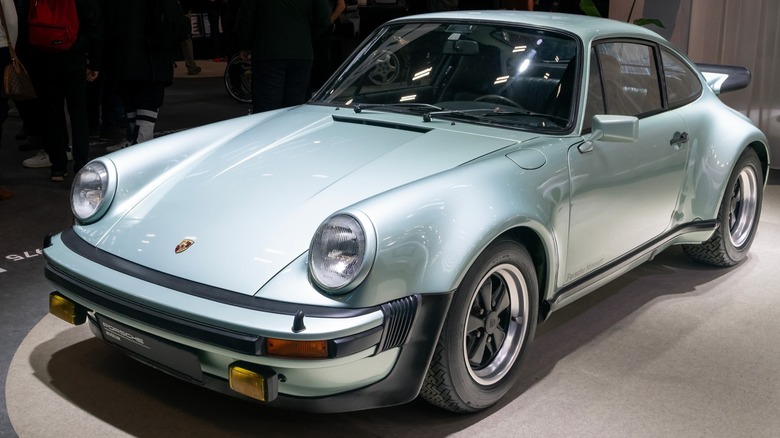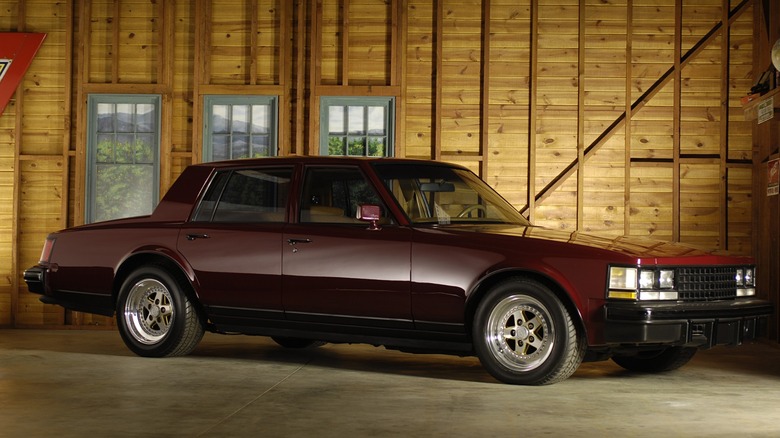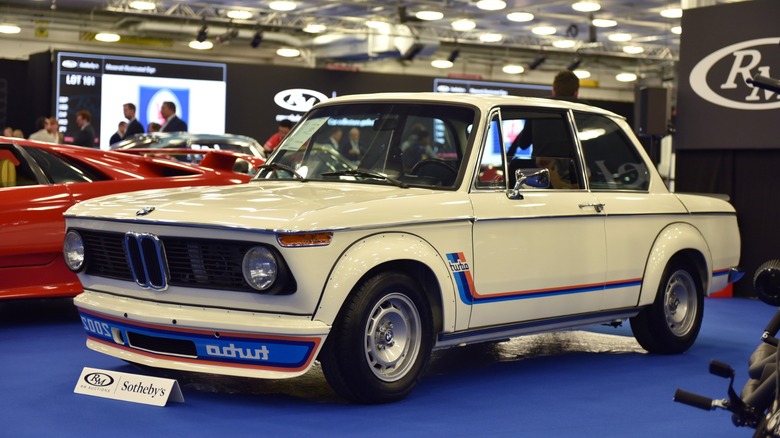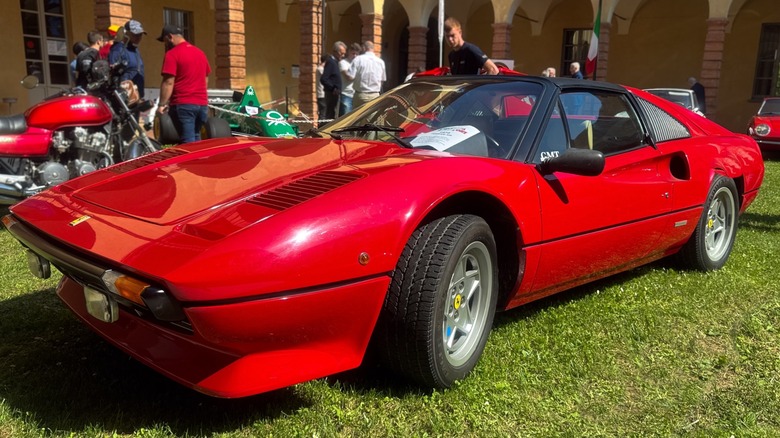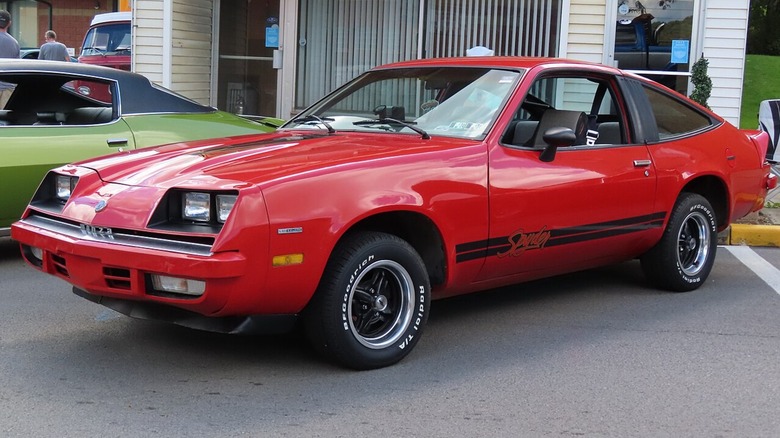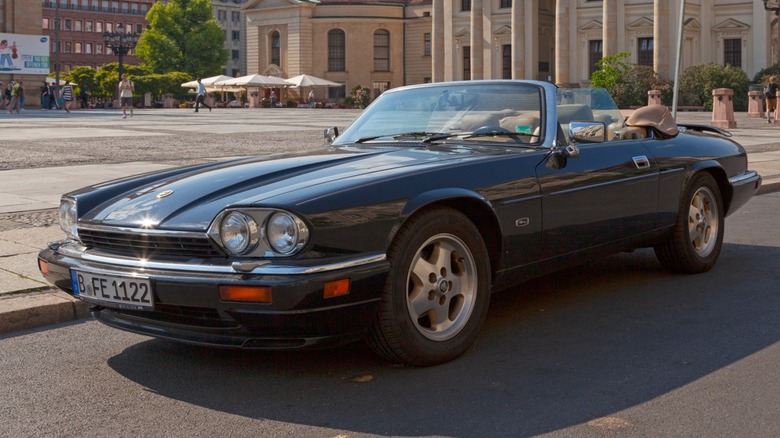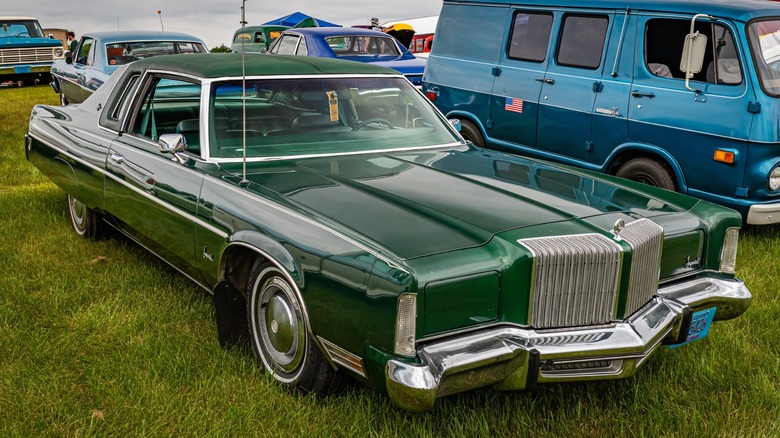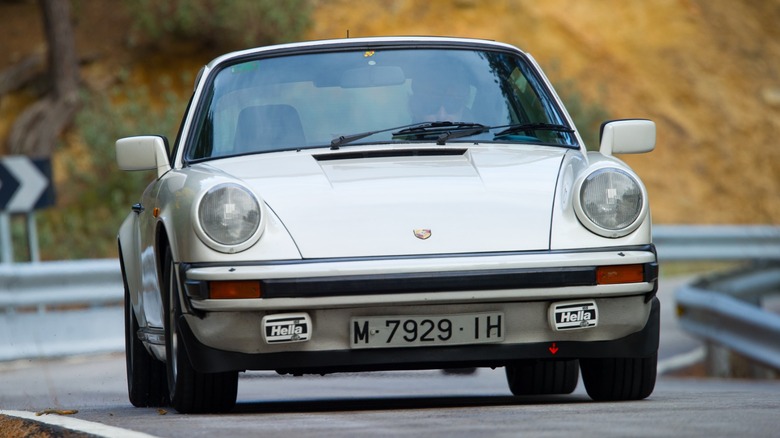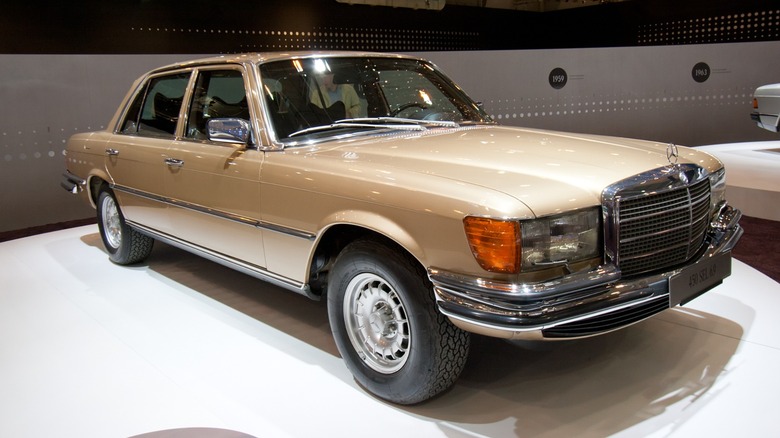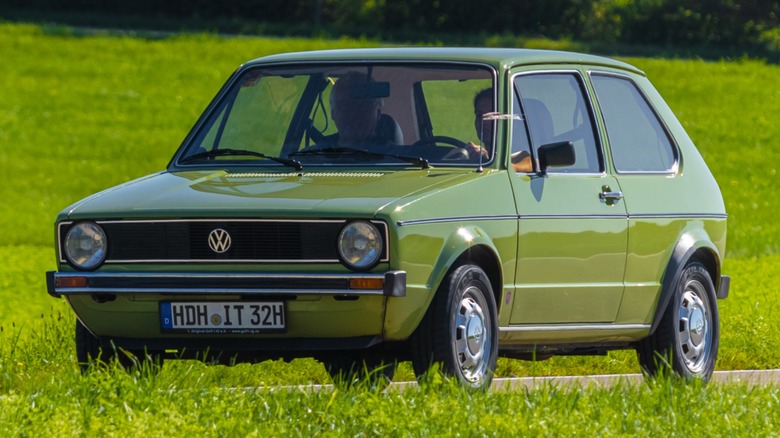The Coolest Cars Everyone Wanted In 1975
Carmakers contended with wide-ranging issues affecting the products they built and ultimately sold to the public. Now widely known as the Malaise Era, the period roughly from 1974 to 1984 delivered disappointment after disappointment to new car dealers across the spectrum of brands and models. The government mandated regulations concerning emissions, efficiency, and safety, while an energy crisis sent fuel prices skyrocketing, leaving drivers stranded with empty tanks. Furthermore, a weak economy beset by stagflation and high interest rates altered consumer buying habits, and manufacturers reacted as quickly as possible, but often failed to deliver automobiles that could be described as satisfactory.
The Clean Air Act forced a reduction in emissions, resulting in a significant drop in horsepower across the industry. The golden era of American muscle cars ended, taking with it some iconic American muscle, like the Chevelle SS 396 and the Mustang Boss 429. Despite the gloomy conditions, manufacturers still managed to build a few gems, and since the regulations only applied to vehicles stateside, buyers outside the country continued to have many attractive options unhindered by the EPA. With hindsight, it is easy to pick and choose the best of these cars. However, thanks to prodigious reporting from automotive magazines of the time, we can see what the press had to say about them and why these cars from 1975 were the coolest models everyone wanted.
Cadillac Seville
Long known for building oversized luxury barges with the plushest interiors and the softest rides, Cadillac found itself at a disadvantage as the decade progressed. Even as it courted the most well-heeled buyers, it found many of its target demographic peeled away by foreign brands offering premium design and engineering in smaller and sportier packages — the smallest 1974 Cadillac was over 220 inches long and weighed 4,600 pounds.
Introduced in 1975 for the 1976 model year was an all-new Cadillac designed and built to take the Europeans head-on. Cadillac first looked to GM's European division, Opel, for something it could adopt as its own, but ultimately decided on making its own car on the same architecture as the then-new Chevy Nova. After undergoing extensive changes to make it a Cadillac, the 1976 Seville was introduced in 1975.
Though smaller than other models from the brand, the Seville commanded a higher price, and because Cadillac only had giant big block engines, an Oldsmobile V8 was used, with the anemic, smelly, and infamously unreliable Oldsmobile Diesel V8 becoming optional in 1978. But above all, it offered classic American luxury, and Auto Motor-Sport noted the difference from European luxury in the way Cadillac used materials, such as cheaper plastics instead of real wood, while making up for it with an abundance of options and accessories, all to good effect.
BMW 2002 Turbo
In 2025, turbocharged cars are fast becoming the norm. While this may feel a bit like a new phenomenon, BMW helped to lay the foundation half a century ago. While the Americans were continuing to dominate the market for big V8-powered barges, West Germany sent us its small four-cylinder 02 Series, which seemed the polar opposite. However, it proved itself as Americans gave BMW its first genuine sales success in North America.
BMW's existing 1.6-liter engine could not pass America's new emissions regulations, so they developed a new 2.0-liter model with the American market in mind. And while the era of oil crises and government regulation saw a precipitous decline in American horsepower, BMW found a way to raise it and gave us the first turbocharged European production car.
Introduced in 1973 and sold through 1975, the BMW 2002 Turbo offered good performance with sporty styling. The output of the 2002 had already hit 130 horsepower thanks to the installation of mechanical fuel injection, and the turbocharged version offered a generous 168 horsepower — 13 more than the 1975 Camaro's V8. The contemporaneous review published in Road & Track initially raised some complaints about lagging performance and somewhat uninspiring low-range driving, but when tested on the BMW track, it opened up nicely once full boost from the turbo was achieved. Sales for this model were less than robust, but not because nobody wanted it — a global oil crisis combined with a high price tag prevented it from becoming a runaway success.
Ferrari 308 GTB
Tom Selleck catapulted the Ferrari 308 GTS into the '80s icon stratosphere as his private detective character on Magnum, P.I., but that model was already a bit long in the tooth upon the show's 1984 debut. Nearly 10 years earlier, Ferrari released a car that helped chart a new course for the company. Known at the time for making beautiful grand touring cars featuring sophisticated V12 engines up front with power headed to the rear, the 308 was the first automobile with a V8 sitting amidships, along with the Prancing Horse and Ferrari badge together on the rear. The V8-powered Dino only wore the Prancing Horse badge.
With styling penned by Pininfarina and body built by Carrozzeria Scaglietti, the new-for-1975 Ferrari 308 GTB became the first Ferrari built with a fiberglass body in addition to being the first to have a V8 in the middle. The V8 displaced 2.9 liters with four Weber carburetors feeding enough fuel for the twin-cam engine to produce more than 240 horsepower. Considering its curb weight of just 3,100 pounds, this was plenty for creating an engaging driving experience.
While the performance is a draw, the 308's styling is definitely its defining feature. In 1977, Road & Track commented that it is, "Stunning to look at, dramatic, sensuous and pleasant from every angle." Furthermore, the article sums it up by explaining why the high price of nearly $30,000 is justified and ending by simply calling it a "fabulous machine."
Chevrolet Monza 2+2 V8
Conversations about the worst cars ever produced by General Motors (GM) generally include the Chevrolet Vega. That was a truly unfortunate car, but not all was lost from the effort. Using the same H-Body platform, Chevrolet introduced the Monza a few years later. It was another compact car originally designed to feature a Wankel rotary engine under the hood. But when poor efficiency and reliability inherent to the rotary design became clear, a conventional power source landed between the front wheels.
Introduced for the 1975 model year, the Monza was a stylish small car built as a 2+2 hatchback with rear seats that seemed more of a suggestion rather than a place for people to actually sit. It was an affordable option to the Camaro that also offered V8 power, however limited it was. At 262 cubic inches, or 4.3 liters, it was Chevy's smallest small-block V8, and rated for just 110 horsepower, it was probably its least powerful.
Most Monza buyers were more preoccupied with economy over performance and bought the more pedestrian notchback in larger numbers. Nonetheless, the 2+2 V8 model managed to impress enough people over at Motor Trend to make it 1975's Car of the Year. Thanks to a range of appearance packages, many Monzas left dealerships looking rather sharp, even if the aftermarket was needed to upgrade performance to match.
Jaguar XJS
Jaguar's legendary E-Type was coming to the end of its life cycle in 1974 as production wound down, and the company needed something to fill its shoes. Furthermore, Jaguar's long-running project to build a V12 engine had finally come to fruition, and it needed a showcase for its first new engine since the 1940s.
While the E-Type was a sleek and sporty car beloved by drivers, the new XJS went decidedly upmarket as Jaguar sought to reach into an upper echelon of buyers by offering a powerful driver's car with an upscale and elegant interior. In addition to the oversized 5.3-liter V12, buyers were ensconced in fine leather, an ample amount of real wood trim, premium options and accessories, and, as noted on Thames TV, it was "uncannily quiet."
As longtime fans of high-performing Jaguars, Road & Track in 1976 lamented the move upmarket for the new cat as its lofty price pushed it out of reach of most sports car enthusiasts. Nonetheless, words like "superb" and "delight" still found their way into descriptions of the meaty V12. And disregarding any personal reservations about the car, it still received high marks for its luxury and performance, and driving it "leaves little to be desired."
Imperial Lebaron
One of the more confounding occurrences of the 1970s concerning automobiles relates to American luxury cars. As the decade progressed, fuel prices shot up and governmental regulations tamped down on emissions — and power — yet American automakers built their most luxurious models increasingly larger. As regular Americans flocked to Toyota and Honda dealers, their bosses bought land barges swathed in plush velvet and chrome.
Sitting atop the Mopar luxury hierarchy was the Imperial LeBaron. Branded separately from Chrysler, the Imperial offered the best of what American automakers could offer. In this case, it seems the best they had was real estate. In the case of the Newport, that equated to a 124-inch wheelbase and an expansive 231-inch overall length. For perspective, this is a few inches more than the longest luxury vehicle currently in production, the Cadillac Escalade IQL, which sits on a full-size truck chassis and has three rows of seats.
Powered by a big but underwhelming 440 V8 – output was only 230 horsepower — these land yachts were made for comfort above all. That is the sentiment of Road Test Magazine in a review of the 1972 model, which suggests anyone spending time behind the wheel might be inclined to purchase one. Revisiting the car in 1975, Road Test conveys mixed feelings about the car overall but does claim that Chrysler had not lost its edge in engineering, citing impressive equipment and performance in handling and braking. Chrysler axed the Imperial brand the next year as changing market conditions no longer favored it.
Porsche 911 (930) Turbo
While BMW may have been the first in the Old World to have added boost to one of its production models, Porsche followed the next year in a big way, establishing high-performance credentials that continue through today. The incredible Porsche 911 Turbos of the past few decades all trace their lineage to the 930 Turbo released in 1974.
Having nearly reached the limits of what it could do with its boxer engine at the time and a growing need to build cars for racing that satisfied homologation rules, Porsche had to do something to gain more power out of its existing engine technology. Already known for squeezing tremendous output from its compact boxer six-cylinder engine, Porsche turned to forced induction to remain competitive. This came on a planned limited production 911 Turbo 3.0-liter model with a power output of 260 horsepower in a well-equipped car with luxury details like leather seats throughout the interior.
The Turbo Porsche turned out to be quite popular and prompted Porsche to increase production to meet demand. Experienced drivers loved the increased power, although turbo lag presented a challenge for novices. Car and Driver reminded readers that even this new and exciting 911 was still an outcropping from the original Beetle, and that its archaic layout could create difficult handling at times. Regardless, that it could beat anything made in America meant it was still the most exciting thing they reviewed that year.
Alfa Romeo Alfetta GT
Alfa Romeo is known for its beautiful cars, and the 1975 Alfetta GT, styled by Giugiaro, is no exception. Powered by Alfa Romeo's longtime twin-Cam four-cylinder initially developed in 1954 up front, the Alfetta GT kept its weight balanced with power sent to the rear wheels through a transaxle mounted in the rear. It then used torsion bar suspension on the front wheels with a de Dion rear axle and inboard disc brakes hugged the transaxle. All this translated into a great handling and fun little car.
The first Alfetta came in 1972 as a small sedan, but not until the 1975 model year did Alfa offer something worth getting excited about, the wedge-shaped GT. The 2.0-liter engine provided enough grunt — 122 horsepower — to make the Alfetta engaging to drive, and the U.S. market versions received Alfa's SPICA mechanical fuel injection, allowing it to comply with emissions regulations without a catalytic converter, although one would be added later. However, the SPICA injection system was sensitive and could be problematic when serviced by technicians inexperienced with it.
It is hard to say just how many people wanted this car in 1975. Alfa sold about 13,000 of them from 1975 to 1979, while 450,000 Alfettas were sold worldwide in all forms, including the sedan. Regardless, Car and Driver in 1976 said, "brisk acceleration to satisfy your lust for speed." Despite any shortcomings in Italian build quality, the car had it where it mattered.
Mercedes-Benz 450SEL 6.9
American drivers in the 1970s continued to enjoy their big and brutish V8-powered luxury sedans, even if they tended to have an overly soft ride and questionable build quality. However, the well-heeled had options outside of Detroit, and Stuttgart delivered a V8, along with superior quality and a perfectly balanced ride.
While the ultra-wealthy and tyrannical despots alike often owned the fabulous Mercedes-Benz 600 Pullman, powered by the M100 6.9-liter V8, Mercedes decided to offer a slightly more down-to-Earth version by stuffing the massive V8 into a smaller 300SEL W109 chassis. New for 1975, the 450 SEL 6.9 offered the ultimate in reserved German luxury. A long list of options included power seats, headlight wipers, multiple leather colors, rear window curtain, and even a car phone — in 1975! Furthermore, this no-expenses-spared passenger car was built incredibly well, and the solid "thud" when closing a door reinforced this point.
Perhaps the only thing one could complain about the 450SEL 6.9 would be the price. Its 360 lb-ft of torque propelled the 4,390-pound beast to 60 mph in 7.1 seconds, as tested by Car and Driver in 1977, and it was said to be nimble and agile while remaining nearly silent. However, the $38,230 price, or $230,526 in 2025 dollars, of the test vehicle still lacked a few options found on lesser vehicles, a valid complaint. Regardless, it was still the car in 1975 that was wanted by those who wanted for little.
Volkswagen Rabbit
Volkswagen had a great run selling its air-cooled Type 1 Beetle for decades. It was one of the best-selling cars for good reason, but by the 1970s, its replacement was imminent. An emissions-friendly water-cooled car with passenger safety upgrades was needed to replace it, while offering reliable and affordable transportation to the masses. This replacement ultimately became the Volkswagen Golf, branded as the Rabbit in North America. It proved to be a worthy successor.
Introduced for the 1975 model year, the Rabbit sold alongside the Beetle until 1977, when it took over as the affordable VW people's car. It was a thoroughly modern vehicle equipped with a water-cooled four-cylinder engine driving the front wheels. The 1.5-liter engine provided 70 horsepower, besting the Beetle by 24 horsepower, and the hatchback design provided superior cargo access. Furthermore, its interior was relatively comfortable, while the styling by Giorgetto Giugiaro made it modern and appealing. Most importantly for American buyers, it offered air conditioning as an option.
At the time, Car and Driver recognized what a seismic shift this car would be for VW, and gave it high marks for ingenuity while recognizing some of its imperfections, such as having to pay extra for disc brakes. Additionally, Road & Track put it through a 24,000-mile test, lamenting that VW quality had fallen but that enthusiasm for the car still did not wane. Ultimately, enough people wanted it in 1975 that the Golf continues to sell to this day.
